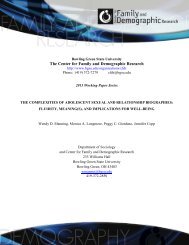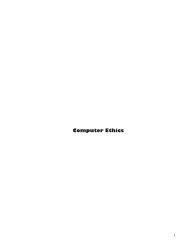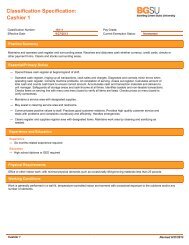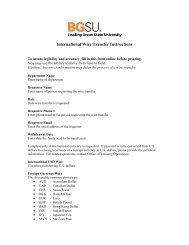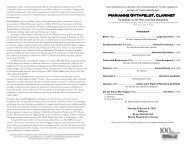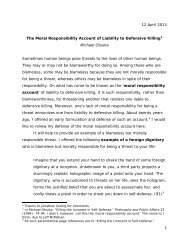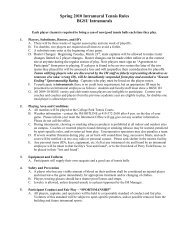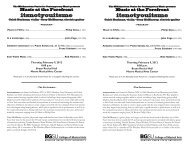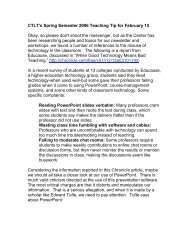National pledge manual - bgsu
National pledge manual - bgsu
National pledge manual - bgsu
Create successful ePaper yourself
Turn your PDF publications into a flip-book with our unique Google optimized e-Paper software.
APRIL 2007<br />
<strong>National</strong> Pledge Manual<br />
DISTRIBUTION RESTRICTION:<br />
Approved for public release; distribution is unlimited<br />
NATIONAL HEADQUATERS<br />
NATIONAL SOCIETY OF PERSHING RIFLES<br />
PRF 310<br />
<strong>National</strong> Society of Pershing Rifles
Pershing Rifles Form<br />
Number 310<br />
PRF 310 – <strong>National</strong> Pledge Manual<br />
NATIONAL PLEDGE MANUAL<br />
Contents<br />
<strong>National</strong> Headquarters<br />
<strong>National</strong> Society of Pershing Rifles<br />
Approved: April 2007<br />
Page<br />
Contents................................................................................................................. 2<br />
The Pershing Rifleman .............................................................................................. 3<br />
Purpose of the Society .............................................................................................. 3<br />
History of the <strong>National</strong> Society of Pershing Rifles .......................................................... 4<br />
1891 - 1920 ........................................................................................................ 4<br />
1920 - 1960 ........................................................................................................ 4<br />
1960 - Present ..................................................................................................... 5<br />
The Life of General John J. Pershing............................................................................ 8<br />
Early Life............................................................................................................. 8<br />
Early Military Career.............................................................................................. 8<br />
Cuba and the Philippines........................................................................................ 9<br />
Marriage and Promotion to Brigadier General .......................................................... 10<br />
Loss of Family and Poncho Villa ............................................................................ 11<br />
The First World War ............................................................................................ 11<br />
Late Military Career............................................................................................. 12<br />
Colors, Insignia and Symbolism ............................................................................... 13<br />
Colors ............................................................................................................... 13<br />
Insignia............................................................................................................. 13<br />
Symbolism of the White Rose ............................................................................... 15<br />
<strong>National</strong> Events ..................................................................................................... 16<br />
Fall Commander’s Call ......................................................................................... 16<br />
<strong>National</strong> Convention and Drill Competition.............................................................. 16<br />
Page 2
PRF 310 – <strong>National</strong> Pledge Manual<br />
The Pershing Rifleman<br />
Pershing Riflemen strive toward excellence in everything they do. They aim to exceed the<br />
standard and encourage others to do the same. Riflemen willfully yield a portion of their<br />
individuality for the good of the group. They recognize “Mission First and People Always”<br />
and accept nothing less than a standard of perfection. Rather than waiting to be ordered,<br />
Riflemen take the initiative and accomplish what needs to be done. He or she is a special<br />
breed; an individual within the group. The Pershing Rifleman is one of the few, the proud,<br />
to have their eyes on the stars and their feet firmly planted on the ground.<br />
This is the legacy you are attempting to join. In order to do so, these ideals must become<br />
your own. Much is expected of you – live up to it.<br />
Purpose of the Society<br />
“The purpose of the <strong>National</strong> Society of Pershing Rifles is to develop, to the highest degree<br />
possible, outstanding traits of leadership, military science, military bearing, and discipline<br />
within the framework of a military oriented, honorary fraternity.”<br />
- General of the Armies of the United States John J. Pershing -<br />
Page 3
1891 - 1920<br />
PRF 310 – <strong>National</strong> Pledge Manual<br />
History of the <strong>National</strong> Society of Pershing Rifles<br />
In 1891 General Pershing, then a second Lieutenant in the Sixth Cavalry, became Professor<br />
of Military Science and Tactics at the University of Nebraska. He, wishing to improve the<br />
morale of the ROTC unit, formed a select company of men, thereafter known as Company A.<br />
In 1892 Company A traveled to the Omaha Drill Competition and won first honors. A year<br />
later, this unique drill unit became a fraternal organization bearing the name of the “Varsity<br />
Rifles.” Out of appreciation for Lieutenant Pershing’s initiative and cooperation, the<br />
organization changed is name to the “Pershing Rifles.” It is this year, 1894, that we<br />
recognize as our official founding.<br />
When Lieutenant Pershing left the University of Nebraska in 1895 he, at the request of a<br />
committee, gave the unit a pair of his cavalry breeches. These breeches were cut into small<br />
pieces and were worn on the uniform as a sign of membership. These “ribbons” were the<br />
first service ribbons worn in the United States.<br />
During the Spanish American War thirty members of the now powerful Pershing Rifles<br />
enlisted in the First Nebraska Volunteers. W.H. Oury, a full Colonel in the U.S. Army and<br />
Captain of the Pershing Rifles, was placed in command. Another Rifleman whose last name<br />
we know to be Ribbons was made the unit’s First Sergeant. (He would later achieve a high<br />
position in the War Department.) Every one of the thirty distinguished himself in the<br />
ensuing battles.<br />
The first decade of the 20 th Century saw the Pershing Rifles reach the height of its existence<br />
prior to the First World War. It was one of the most important features of Nebraska military<br />
and social life. Membership was considered a great military honor. Its influence in the<br />
Military Department continued strong until 1911.<br />
After 1911 the organization suddenly lost prestige and declined deplorably. Its activity<br />
suddenly seemed to cease and the organization became a shadow of its former self. As this<br />
happened, military influence plummeted and the social activities were dropped. The<br />
conditions became so deplorable that in 1917 the organization was disbanded and its<br />
records were burned. Thus, in seven brief years, this promising organization passed from<br />
national renown into oblivion.<br />
1920 - 1960<br />
In 1920 the Pershing Rifles, like the phoenix, was reborn. Out of the ashes of the<br />
organization, killed by its own weight in 1917, there sprang a corps with new life and<br />
activity. The prestige it has experienced at the turn of the century was not so quick to<br />
return. As organized in 1920, the Pershing Rifles became an organization for junior officers.<br />
Soon however, it regained its status as a basic military society. The presence of Scabbard<br />
and Blade on the Nebraska campus probably prevented its growth as an officer’s<br />
organization.<br />
The growth of the Pershing Rifles after its reorganization is perhaps even more remarkable<br />
than its former decline. It stepped back into it old niche and worked to grow large enough<br />
to once again fill its own shows. By 1924 the prestige of the organization was once again<br />
Page 4
PRF 310 – <strong>National</strong> Pledge Manual<br />
on the rise. Special drill units across the nation began to seek admittance into the Pershing<br />
Rifles.<br />
Meanwhile, in the fall of 1922, a group of advanced course men at Ohio State University<br />
joined together and former “The President’s Guard.” It was so named in honor of William<br />
Oxely Thompson, President of Ohio State University. The guard preformed an exhibition<br />
drill routine on Military Field Day in the spring of 1923. After this performance the unit was<br />
disbanded. In the fall of the same year the commander of the local Scabbard and Blade<br />
chapter reorganized the unit. Basic course men however, were not admitted.<br />
This new organization was too loosely organized and too closely connected with the<br />
university’s established drill unit for it to stand alone. In the spring of 1925 it applied for<br />
affiliation with the Pershing Rifles, but the Nebraska organization refused. The Ohio State<br />
group, seeing the need for a national organization for basic course men, threatened to<br />
nationalize “The President’s Guard” and leave Nebraska out of it is the two organizations<br />
could not work together. Finally, after a year of negotiations, the Nebraska organization<br />
approved the formal application for the Ohio State organization. This application was dated<br />
13 May 1925. John A. Picker, Colonel of the Pershing Rifles, installed the chapter on 22 May<br />
1925. Thus was inaugurated a new chapter and policy that welcomed units nation-wide into<br />
the Pershing Rifles.<br />
In 1927 the <strong>National</strong> Headquarters in Lincoln granted the University of Tennessee’s crack<br />
drill unit a charter. This group was designated Company C, and was established under the<br />
influence of the Scabbard and Blade chapter located at the school. From this time until<br />
1929, the Nebraska unit focused on the establishment of strong local units based on the<br />
belief that if local units were strong, a national organization could be easily organized.<br />
Using this mentality the Pershing Rifles at Nebraska surpassed even its Spanish American<br />
War greatness.<br />
The year 1928 brought the establishment of an official <strong>National</strong> Headquarters at the<br />
University of Nebraska. This built the foundation for a strong national unit. In the summer<br />
of the same year, a number of circulars were sent to universities that did not hold a<br />
Pershing Rifles unit, inviting their crack drill units to apply for charters from the <strong>National</strong><br />
Headquarters. Those who knew the value of the Pershing Rifles as an organization capable<br />
of promoting interest in drill work for basic students heeded the circulars. During that<br />
summer, officers attached to the schools where Pershing Rifles chapters were hosted met<br />
with officers from other institutions and as such, the organization received excellent<br />
publicity.<br />
By 1935 the Pershing Rifles had grown to 22 Companies and was split into three Brigades<br />
and six Regiments. On 23 April of that year, General Pershing returned to the <strong>National</strong><br />
Headquarters to meet with the <strong>National</strong> Staff and the winner of that year’s Pershing Medal.<br />
He was keenly interested in the happenings of the Society, including finances, expansion,<br />
drill competition, and the publication of The Pershing Rifleman, a publication that continued<br />
uninterrupted until 1973 and included letters from General Pershing as well as other highranking<br />
military officials. It was during this time that the leadership began to push for<br />
standardization including the use of cords and stationary to help promote unity. A smallbore<br />
rifle competition was the national event and was enthusiastically support by all units.<br />
1960 - Present<br />
Over the next several decades, the Pershing Rifles continued to grow. In 1961, the Society<br />
was comprised of 139 active units with nearly 4,100 initiates for that year alone. Several of<br />
Page 5
PRF 310 – <strong>National</strong> Pledge Manual<br />
the 15 active Regimental Headquarters’ had to split into battalions or added inspection<br />
teams to help with the ever-increasing numbers. Beginning in 1962, the Army and Air<br />
Force ROTC systems began undergoing a change in operation and structure. As such, the<br />
Pershing Rifles began to look for new ways to adapt to the changes. Alumni programs were<br />
expanded to include the formation of a tri-service advisory board of retired and reserve<br />
officers to help guide the Society. Various units from around the country also began to<br />
work with high school JROTC units and brought in a parallel organization on that level<br />
known as the “Blackjacks.” During the 1964-65 academic year the operational changes in<br />
the ROTC program that had rumored in 1962 came into full implementation under the ROTC<br />
Reorganization Act. Due to these changes, there were fewer cadets enrolled in ROTC<br />
programs to begin with, hence making expansion more difficult, as would be the case with<br />
maintaining the size of Pershing Rifles units.<br />
The core of the Society remained strong. Two new Regimental Headquarters’ were added<br />
between 1962 and 1965, brining the number up to seventeen, and the number of units to<br />
149.<br />
At the 1967 <strong>National</strong> Convention, the Society officially brought in a second dimension to the<br />
Pershing Rifles – the Pershing Rifles Aggressor Force. The Aggressor Force was<br />
implemented to encourage the training and development of tactics and bring a combative<br />
dimension necessary to mastering the changing world members would enter as military<br />
officers. The 5 th Regimental Headquarters, hosted by Pennsylvania State University, was<br />
charged with drawing up the Standard Operating Procedures and national policy regarding<br />
these units.<br />
1969 marked the Pershing Rifles’ 75 th anniversary. The organization received salutations<br />
from President of the United States John F. Kennedy, Chief of Staff of the U.S. Air Force<br />
General Curtis E. LeMay, and Chairman of the Joint Chiefs of Staff General of the Army<br />
Omar N. Bradley. These were published to honor the Society’s history and achievements.<br />
The face of the Pershing Rifles continued to evolve with the changes of society. The<br />
Pershing Rifles disappeared from many schools following the Vietnam War with the<br />
dissolution of ROTC programs and the end of compulsory ROTC basic courses. In response<br />
to the shrinking number of units and Riflemen within these units, the <strong>National</strong> Headquarters<br />
increased the emphasis on tactics and marksmanship. By 1974 the Pershing Rifles was<br />
organized into thirteen regiments comprised of 137 units.<br />
The 1970s saw the introduction of women into the <strong>National</strong> Society of Pershing Rifles, with<br />
the first female <strong>pledge</strong> at Company L-4 (North Carolina State University) n 1971 and the<br />
first female active member from M-16 (Florida State University) a year later. This does not<br />
however, imply a lack of participation or association with the Pershing Rifle before the<br />
1970s. The Co-Ed Affiliates of Pershing Rifles (CAPERS) had established units along side<br />
Pershing Rifles units for decades. Even earlier, a sponsor was often chosen as an honorary<br />
addition to various staffs. When the Society opened its doors to women, CAPERS units were<br />
invited to join.<br />
In 1980 the Pershing Rifles selected its first female commander, Paula R. Harmon. During<br />
the same decade, units across the nation increased focus on different aspects; some<br />
marksmanship, others tactics and hostage situation training, while still other held true to<br />
the foundation of the Society, armed exhibition drill. Competitions were held for each of<br />
those activities throughout the year with the drill competition still taking the spotlight. In<br />
celebration of its 90 th Anniversary, the Governor of Nebraska presented a citation for<br />
Page 6
PRF 310 – <strong>National</strong> Pledge Manual<br />
outstanding service to the state as well as declaring a week in March to be Pershing Rifles<br />
week.<br />
In the early 1990s increases in participation were seen through more regimental sponsored<br />
competitions and social events. Expansion efforts continued throughout the decade in spite<br />
of fluctuations in active units. Following managerial problems at the regimental level, the<br />
<strong>National</strong> Legislative Body dissolved all Regimental Headquarters’ in 1997. Discovering that<br />
rather than solving problems, the removal of this level of command increased problems,<br />
especially in communication, camaraderie, and participation at national events, Regimental<br />
Commands were re-established starting with the 8 th Regimental Headquarters in 2001. The<br />
1 st , 4 th , 12 th , and 17 th Regimental Headquarters followed suit in 2002-2003, with the 2 nd<br />
Regimental Headquarters being established a year later. Currently, 1 st , 2 nd , 4 th , 8 th , 9 th , and<br />
17 th Regimental Headquarters’ are operational.<br />
Page 7
Early Life<br />
PRF 310 – <strong>National</strong> Pledge Manual<br />
The Life of General John J. Pershing<br />
John Joseph Pershing was born on 13 September 1860 near the frontier town of Laclede,<br />
Missouri. His father John Fletcher Pershing left the Pennsylvania farmland to seek a new life<br />
with the booming railroad industry. His innate leadership kills soon saw him installed as a<br />
foreman on his company’s track laying crew in Tennessee. It was here that he met Ann<br />
Elizabeth Thompson and, after a whirlwind courtship, they were married. The couple<br />
followed the employment opportunities of the railroad to Missouri, where Ann prepared for<br />
the birth of her first child. As the work camp they live in lacked adequate resources for<br />
childbirth, Mrs. Pershing was moved to the town of Laclede.<br />
John J. Pershing spent his early years at work with his father. His family settled in Laclede<br />
where his father ran a farm, a general store, and speculated in real estate with mixed<br />
successes over the years. At the age of four, Pershing was given his first taste of warfare<br />
during the American Civil War. He was witness to skirmishes between his family and<br />
Confederate raiders, and with a garrison of Union soldiers. His childhood is filled with<br />
typical stories of growth and mischief. However, clearly present from an early age was a<br />
character of discipline, courage, and determination modeled after his childhood hero,<br />
George Washington.<br />
It was in 1875 that John Pershing began to rise as his own man. Pershing found his family<br />
in dire financial trouble after a drought ruined his father’s over-ambitious land investments.<br />
Because of this, his father left to seek employment, and young John sought work in<br />
Laclede’s school for black children. Though Pershing was very young, he obtained the job<br />
due to his reputation for scholarly qualities, and the undesirability of the position itself.<br />
Despite the heckling of his peers, Pershing undertook the job with skill and pride, resolutely<br />
defending the honor of his position.<br />
Pershing worked as a teacher in Laclede and later another nearby town until in 1882 a<br />
competitive examination was held for entrance into the United States Military Academy.<br />
Though Pershing had ambitions to become a lawyer, he saw West Point as a remarkable<br />
opportunity to receive a first rate education. Pershing won the competition and reported to<br />
West Point in September of 1882.<br />
Early Military Career<br />
Pershing, while above the average, was not a great student. He graduated 30 th in a class of<br />
77. Pershing did however, stand out as a leader with exception military bearing; Cadet<br />
Page 8
PRF 310 – <strong>National</strong> Pledge Manual<br />
Pershing was appointed to the highest possible cadet rank during each of his four years at<br />
the academy. Due to his excellent performance, Pershing was commissioned into the<br />
cavalry and sent west.<br />
Lieutenant Pershing began his career with the 6 th Cavalry on 30 September 1866 at Fort<br />
Bayard, New Mexico. This was the period of the battles against the Apache warrior<br />
Geronimo. Pershing accomplished many commendable feats during this time, most notably<br />
commanding a detachment charged with setting up a heliograph line – a kind of<br />
communication relay utilizing mirrors and the sun – across 160 miles of rough terrain filled<br />
with hostile Indians. Pershing was later hand selected by General Nelson Miles to command<br />
his Indiana Scouts during the Sioux uprising in South Dakota. By the 1890s, the Army<br />
finally pacified the last of the major Indian resistance in the west.<br />
With the west pacified, Pershing again found himself filling the role of a teacher. On 15<br />
September 1891, he became the Professor of Military Science and Tactics at the University<br />
of Nebraska in Lincoln, Nebraska. This proved a daunting task. The late 19 th century<br />
equivalent of the ROTC existed to training college students in the art of war should the<br />
populace be called to serve as they had in the Civil War. However, in the peaceful<br />
atmosphere of the time, Pershing inherited command of a program with no real spirit.<br />
The Battalion of Cadets numbered 90 on Pershing’s arrival. Within a very short period of<br />
time however, that number had expanded 350. The students stood in awe of the veteran<br />
2 nd Lieutenant, always magnificently dressed, stern, and missing no detail. Pershing’s<br />
honest commitment to excellence was contagious; his spirit invigorated the students. By<br />
November of 1892 the quality of the Cadet Battalion was greatly enhanced, and Pershing<br />
was promoted to 1 st Lieutenant.<br />
During this time, Pershing suggested the unit’s participation in a national drill team<br />
competition in Omaha, Nebraska. This was the origin of the Pershing Rifles. They began as<br />
an elite 45 man team, drilling twice a day for two months. Their harshest inspector was<br />
Pershing himself, who rigidly ensured the unit did not succumb to overconfidence. In<br />
Omaha, the Pershing Rifles competed against the finest drill units in American, and won.<br />
Pershing continued teaching in Nebraska until 1895 when he was reassigned to the 10 th<br />
Cavalry in Montana, a black regiment command by white officers. Pershing served with<br />
distinction until he was noticed again by General Miles, who selected Pershing as an aide in<br />
Washington D.C. After six months of duty with General Miles, Pershing returned to West<br />
Point as an instructor of tactics.<br />
Pershing’s success with the cadets of Nebraska did not follow him to New York. The cadets<br />
of West Point detested Pershing for his high standards, and subjected him to various pranks<br />
and “the silence;” a cold tradition where all cadets stand stone-like at attention for as long<br />
as an unpopular officer occupied the mess hall with them. However, the lasting legacy of<br />
the cadets was to assign Pershing a nickname scathing in its hatred of the officer who had<br />
come from the all black 10 th Cavalry. They called him “Nigger Jack.” This name stuck with<br />
Pershing, being used by his detractors throughout his career until reporters in the 1 st World<br />
War censored it to the surname he is now remembered by: Black Jack.<br />
Cuba and the Philippines<br />
In 1898, the destruction of the battleship Maine sent American blundering into war.<br />
America conquered the Philippines, and an expeditionary force prepared to invade Cuba.<br />
Pershing, through persistence, succeeded in returning to the 10 th Cavalry to take part in the<br />
Page 9
PRF 310 – <strong>National</strong> Pledge Manual<br />
Cuban campaign. The 10 th Cavalry, one of the few seasoned and professional units in a<br />
campaign of amateurs, covered itself with glory. The dismounted buffalo soldiers of the 10 th<br />
seized the hill of El Caney, part of the San Juan heights, alongside Teddy Roosevelt’s Rough<br />
Riders. Pershing received his promotion to Captain while en route to the Philippines in<br />
recognition for his bravery. Pershing’s regimental commander, a veteran of the Civil War,<br />
praised Pershing as the bravest man under fire he had ever seen.<br />
In August of 1899, Pershing arrived in the Philippines to serve as adjutant general of the<br />
Department of Mindanao. There, he served in various campaigns against the Moros, a tribe<br />
of Islamic fundamentalists that the Spaniards had never been able to subdue. Pershing was<br />
then posted to Camp Vicars in the Mindanao region. However, after his promotion and the<br />
transfer of the Colonel commanding the post, Pershing found himself the ranking officer.<br />
Pershing filled this duty admirably, winning many of the Moro tribes by diplomacy, and a<br />
few others by the sword.<br />
During all his Philippine campaigns, Pershing’s military leadership was unquestionably<br />
brilliant. However, his secret to success was in understanding and respecting the customs<br />
of the Moro tribesman and seeking to mesh the conflicting cultures of tribalistic Islamic<br />
fundamentalism with American governing control. In light of his successes, a movement<br />
began to promote Captain Pershing to the rank of Brigadier General. This movement<br />
involved many general officers who had observed Pershing’s ability, and extended directly<br />
to President Theodore Roosevelt who proposed the idea in an address to Congress.<br />
Marriage and Promotion to Brigadier General<br />
Pershing returned to Washington in late 1903. He was introduced to Helen Frances Warren,<br />
daughter of an influential Wyoming Senator. This began a passionate and brief courtship<br />
that lasted until Pershing was assigned to serve as an observer of the Russo-Japanese War.<br />
Though Pershing had been something of a lady’s man throughout his life, the couple’s<br />
feelings for each other were deep and utter. They were married on 26 January 1905 – the<br />
day before Pershing sailed for Tokyo. While in Japan and Manchuria, Pershing’s keen eye<br />
observed many lessons that would be all too useful when war came to Europe. Pershing<br />
first daughter Helen was born on 08 September 1906 in Tokyo.<br />
In a spectacular coup, President Theodore Roosevelt, with the power to personally<br />
commission officers as either 2 nd Lieutenants or Brigadier Generals, gave Pershing his first<br />
star. Captain Pershing was promoted to Brigadier General over 862 senior officers: 257<br />
Captains, 364 Majors, 131 Lieutenant Colonels, and 110 Colonels. Many cried foul, citing<br />
Pershing’s marriage as the real reason for the promotion. Accusations of scandalous<br />
relationships during his time in the Philippines filled headlines. Roosevelt stood by General<br />
Pershing however, and in time the storm subsided.<br />
Following his promotion, Pershing returned to the Philippines to take command of Fort<br />
McKinley, near Manila. On 24 March 1908 his second child, Anne, was born. The Pershings<br />
stayed until forced a new assignment. They traveled from Asia to Europe through Russia to<br />
observe a brewing conflict in the Balkans that did not materialize. In 1909 the family<br />
returned to America.<br />
On 24 June 1909, Pershing’s only son Warren was born in Wyoming. Shortly thereafter,<br />
Pershing was returned to the Philippines due to the instability of the Moro province. Due to<br />
Pershing’s calm leadership the Moro tribesmen were disarmed, and violence avoided.<br />
During this service, Pershing’s last daughter Mary Margaret was born on 20 May 1912.<br />
Page 10
Loss of Family and Poncho Villa<br />
PRF 310 – <strong>National</strong> Pledge Manual<br />
Pershing returned to the United States to take charge of the 8 th Brigade in San Francisco.<br />
His mission was to patrol the Mexican – American border in response to the wave of<br />
instability and revolution sweeping Mexico. Pershing established his family in San Francisco<br />
before heading to Fort Bliss, Texas to take command of the unit.<br />
After one year of preparations for the family at Fort Bliss, the Pershings were prepared to be<br />
reunited as a family. However, on the morning of 27 August 1915, Pershing was awakened<br />
by a telephone call from the Associated Press mistaking Pershing for his aide, and reporting<br />
one more news of a fire. The correspondent soon realized he was not speaking to a<br />
lieutenant as Pershing demanded information. A fire during the next had killed his wife and<br />
their three daughters by smoke inhalation. Only his son Warren was rescued, unconscious,<br />
from the blaze. This was a mortal blow to Pershing, one from which he never fully<br />
recovered.<br />
In March of 1916 Pershing, still distraught from his loss, was assigned to pursue the<br />
Mexican bandit Poncho Villa. The revolutionary had provoked the wrath of the United States<br />
by raiding border towns. Pershing threw himself into the task to overcome his grief. The<br />
campaign of the American Army through Mexico was one of miserable conditions with little<br />
hope of capturing Villa. Throughout the campaign however, Pershing remained a firm<br />
leader. He was always sharply dressed, always clean-shaven, and usually wearing a tie.<br />
On more than one occasion, his mere presence was enough to diffuse potentially hostile<br />
situation with pro-Villa Mexican locals.<br />
The First World War<br />
General Pershing returned to America in January of 1917. Though the Army had not<br />
captured Poncho Villa, they had successes in taking away his ability to harass American<br />
towns. The campaign also gave the Army much needed experience in handling large<br />
numbers of troops in the field. This experience was a principle reason for the selection of<br />
Pershing to lead the American Expeditionary Force going to Europe following the entry of<br />
the country in the Great War on 05 February 1917. Pershing and a small staff that would<br />
form the core of the American War Machine sailed for Europe on 28 May 1917.<br />
General Pershing, now a Major General with the temporary rank of full General, faced the<br />
largest and most difficult task of his career; assembling and training an American Army in<br />
Europe while keeping his forces independent of foreign commanders. Over three years of<br />
bitter trench warfare had nearly bled white the manpower of the British and the French.<br />
The French, whose Army by this time was in a state of mutiny, expected Americans to be<br />
used as replacement in French units. (The British, although in a better state than the<br />
French, believed the same who happen with American troops in British units.) Neither<br />
President Wilson nor General Pershing would have any of it.<br />
Perhaps the most outstanding legacy of General John Pershing was his stubborn insistence<br />
on not wasting American lives under foreign commanders. American troops would fight in<br />
American units with American leadership. Great pressure was placed on Pershing from the<br />
French and the British, but Pershing would not budge. The doughboys would not be wasted<br />
as replacements; they would fight only as Americans when they were prepared.<br />
Pershing’s care for his men was unquestionable. So too was his demand for<br />
professionalism. Pershing ordered that American soldiers would be clean-shaven, uniforms<br />
Page 11
PRF 310 – <strong>National</strong> Pledge Manual<br />
pressed, and leather polished. He inspected units, watch battle drills, and insisted poor<br />
performances be repeated until deficiencies were corrected. No detail was too small to<br />
escape the eyes of the Commander in Chief of the American Expeditionary Force.<br />
The Army’s first test came at Cantigny on 28 May 1918. In the coming months, Pershing<br />
would lead America’s Army as an independent force through the St. Mihiel Salient offensive<br />
in September of 1918 and the Meise-Argonne offensive shortly thereafter. These were<br />
costly, hard won victories. However the influx of fresh Americans tipped the scales in<br />
Western Europe. This led to the German collapse from within, and the armistice of 11<br />
November 1918. Pershing however, was unsatisfied. He believed that allowing the German<br />
armies to return home without the shame of surrender would cause many Germans to<br />
believe they had not been defeated militarily. Pershing believed the result would be another<br />
war in Europe.<br />
Late Military Career<br />
Pershing returned to America on 08 September 1919 to a hero’s welcome. His final duties<br />
in the military were filled with public relations tours, tempered with close involvement in his<br />
son’s upbringing. Though Pershing felt he could not refuse political office if the American<br />
people demanded it, no such demand came and Pershing made no effort to seek it. At the<br />
height of his triumph, Pershing remained a humble and professional soldier.<br />
General Pershing’s final assignment was to serve in the relatively new Chief of Staff of the<br />
U.S. Army position. During this time, congress honored Pershing by promoting him to the<br />
permanent grade of General of the Armies of the United States, a rank higher than any<br />
other American General until the honor was posthumously bestowed on George Washington<br />
in 1976.<br />
Pershing retired from active duty in 1924 at 64 years of age. He published a two-volume<br />
memoir on his experiences in the First World War, which was a clinical study of interest only<br />
to historians. Pershing regarded this as a poor effort, and a second attempt was deemed no<br />
better by the General, and was never published.<br />
Pershing’s health soon drove him from public service. He remained active in advocating the<br />
United States military and continued preparedness for war, and sought to remain active in<br />
American military matters.<br />
John Joseph Pershing, General of the Armies of the United States, died on 15 July 1948 at<br />
Walter Reed Hospital. He is buried in Arlington <strong>National</strong> Cemetery. He was a man of<br />
ordinary background who rose to extraordinary heights by virtue of his own commitment to<br />
excellence. More than a great soldier, Pershing stands as one of the truly great Americans;<br />
a truly self-made man incorruptibly by the power he achieved. His life of dedication to<br />
excellence will forever stand as a shining example for the American soldier, and the<br />
American citizen.<br />
Page 12
Colors<br />
PRF 310 – <strong>National</strong> Pledge Manual<br />
Colors, Insignia and Symbolism<br />
The colors of the <strong>National</strong> Society of Pershing Rifles are Blue and White. These colors have<br />
traditional national significance and each represent the cornerstones of the Society and its<br />
members.<br />
Blue<br />
Insignia<br />
White<br />
• Loyalty<br />
• Devotion<br />
• Friendship<br />
• Truth<br />
• Purity<br />
• Cleanliness of Life<br />
• Rectitude of Conduct<br />
The Crest<br />
L.G. Balfour of Attleboro, Massachusetts designed the Pershing Rifles Crest, which was<br />
adopted at the 1932 <strong>National</strong> Convention by the <strong>National</strong> Legislative Body. The official crest<br />
consists of a Grecian helmet and torse over the inscription “Pershing Rifles” and the<br />
founding date “1894.” The crest is a guide for the members in our organization. It tells a<br />
little of our history and explains through the various symbols what is expected of us as<br />
Pershing Riflemen, officers, and as ladies and gentlemen. Each part of the coat-of-arms<br />
bears some significance pertaining to the Pershing Rifles<br />
A. CHAMELEON: The Chameleon, which was not part of the originally adopted crest, is<br />
the symbol of the tri-service aspect of the fraternity. After becoming a tri-service<br />
organization, the Society added the Chameleon to represent its members’<br />
adaptability to change and constant preparedness.<br />
Page 13
PRF 310 – <strong>National</strong> Pledge Manual<br />
B. HELMET: The Helmet is the symbol of the chivalry of the medieval knights. This<br />
spirit is the cornerstone of the character of every Pershing Rifles member. It is a<br />
prime requisite for conduct, a necessary part of every true heart. It symbolizes both<br />
the courage of the membership of the Society and the Society’s protection of its<br />
members.<br />
C. TORSE: The Torse, a six-divisional rope just below the Helmet, denotes the romantic<br />
aspect of the heraldry and is the symbol of the chivalrous attitude for the men for<br />
womanhood. It is representative of the Pershing Rifles Cord.<br />
D. SHIELD: The Shield, which bears the Crossed Rifles and Torch, is the symbol of the<br />
readiness of the Rifleman to meet any situation anywhere, on the battlefield or<br />
wherever we may be called.<br />
E. CROSSED RIFLES: The Crossed Rifles, crossed saltier-wise on the escutcheon of<br />
Pershing Rifles form a chevron, which has been noted as an emblem of service and<br />
of helping one another, here representing the spirit of friendship and the cooperative<br />
efforts of units in the Society in serving on another. The Crossed Rifles can also be<br />
seen as a symbol for power and military strength for the insurance of peace.<br />
F. TORCH: The Torch, flamed and superimposed over the Crossed Rifles, represents<br />
four values inherent to the Society. First, in its entirety, the torch stands for<br />
indomitable leadership embodying both the dutiful following of instructions, like true<br />
soldiers, and the intelligence issuance of command. It stands also for the eternal<br />
flame of true friendship, a fundamental quality inherent within the Society. The<br />
Torch also denotes scholarship and knowledge. To meet the demands of leadership,<br />
we must have knowledge. It does not mean just the “minimum effort” of<br />
scholarship.<br />
G. SCROLL: The Scroll bears the name of our organization and the year of its founding.<br />
The Rank Shield<br />
The Pershing Rifles Officer Rank Shield is blue in color, trimmed in silver, and almost<br />
identical in nature to the Shield found in the Pershing Rifles Crest. Officer Rank Shields<br />
include a Torch and Crossed Rifles. The rank of the officer within the Society is denoted<br />
towards the top of the shield, above the Torch and Crossed Rifles.<br />
The Junior Enlisted and Non-Commissioned Officer Rank Shield is again, blue in color, but<br />
trimmed with gold. A small gold version of the Shield found in the Pershing Rifles crest<br />
rests above the chevrons.<br />
Although a service specific devoice denoting rank is present to recognize our tri-service<br />
affiliation, it is important to note that a Rifleman steps out of his or her service in interest of<br />
the Brotherhood. It is for this reason that the Shield, Torch, and Crossed Rifles are the<br />
basis for both the Officer and Enlisted Rank Shields. We are proud to be tri-service in<br />
nature and recognize that our ability to work together now will increase our effectiveness on<br />
the battlefields of the future.<br />
The Cord<br />
The Cord is a symbol of honor bestowed to the Pershing Rifles member upon initiation and is<br />
to be worn on the left shoulder. The cord is purpose and white with the tip bearing the<br />
Page 14
PRF 310 – <strong>National</strong> Pledge Manual<br />
Pershing Rifles Crest. The original colors of the Chord were blue and white – the colors of<br />
the Society. Legend has it that during World War II along with many other rationed items,<br />
blue dye was in short supply. The company that made cords substituted purpose for the<br />
blue. Following the war and the end of rationing, the cords returned to blue and white for a<br />
short period of time. In the wake of the Vietnam War and in honor of sacrifices made in<br />
that conflict as they have been during World War II, the cord was once again returned to<br />
purple and white and has remained as such since.<br />
The Membership Ribbon<br />
The design of the Membership Ribbon is identical to the Army Good Conduct Medal (except<br />
in color), which denotes exemplary conduct at all times. It is worn on the left breast of the<br />
uniform. The six white stripes on the membership ribbon, from the wearer’s right to left<br />
stand for:<br />
A. Devotion to Duty and Country<br />
B. A Bold and True Heart<br />
C. Readiness to Meet any Situation<br />
D. Leadership<br />
E. Military Proficiency<br />
F. Scholarship<br />
The Pledge Ribbon<br />
The Pledge Ribbon is half blue and half white. It is worn on the left breast<br />
of the uniform with the white segment to the left. It serves to remind<br />
prospective members of the values portrayed in the colors blue and white.<br />
Symbolism of the White Rose<br />
The official flower of the <strong>National</strong> Society of Pershing Rifles is the white rose. Traditionally,<br />
this flower represents the most important man or family of the era. For the Pershing<br />
Rifleman, the white rose symbolizes the great life of our founder and patron, General of the<br />
Armies John Joseph Pershing, who made the ideals of the Pershing Rifles a reality.<br />
Page 15
Fall Commander’s Call<br />
PRF 310 – <strong>National</strong> Pledge Manual<br />
<strong>National</strong> Events<br />
Fall Commander’s Call (FCC) is an annual meeting for the leadership of the Society.<br />
Historically, the event is held at the University of Nebraska in Lincoln, Nebraska. The<br />
Company Commander and his or her Executive Officer are expected to attend. If the<br />
Company Commander is unable to be present, it is expected that he or she will be<br />
represented properly. This meeting includes reports by the <strong>National</strong> Headquarters, the<br />
Alumni Advisory board, and each Regimental Headquarters. In addition, Company<br />
representatives are able to propose legislation which is then discusses and voted on. If<br />
passed at the Fall Commander’s Call, the legislation then goes before the <strong>National</strong><br />
Legislative Body at the <strong>National</strong> Convention where if passed, it is enacted.<br />
<strong>National</strong> Convention and Drill Competition<br />
The <strong>National</strong> Convention (NATCON) is an annual event hosted by a unit within the Society.<br />
Its location is determined one year in advance at the previous <strong>National</strong> Convention. The<br />
<strong>National</strong> Convention is the major legislative session of the year where the items proposed<br />
and passed at the Fall Commander’s Call are discusses and receives a final vote; the next<br />
<strong>National</strong> Commander is selected; and all new units are officially brought into the<br />
organization.<br />
In conjunction with the legislative meeting, the <strong>National</strong> Drill Competition is also held. This<br />
is the opportunity for Pershing Rifles units to display their skills as individuals, duos, squads,<br />
and platoon in various regulation and exhibition events. These events are open to all fully<br />
initiated Riflemen within the Society. This is an important time for building the bonds of<br />
Brotherhood on the national level, and as such, it is a very important event for all the<br />
Society’s units.<br />
Page 16
By Order of the <strong>National</strong> Legislative Body:<br />
Official:<br />
Christopher D. Scheuermann<br />
Major General, Pershing Rifles<br />
Commanding<br />
DISTRIBUTION:<br />
PRF 310 – <strong>National</strong> Pledge Manual<br />
This publication has been authorized for public distribution.<br />
PRF 310<br />
24 APRIL 2007<br />
Page 17



